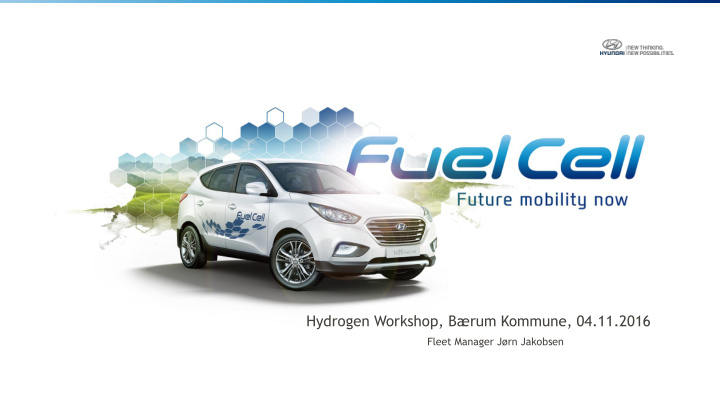



Hydrogen Workshop, Bærum Kommune, 04.11.2016 Fleet Manager Jørn Jakobsen
Hyundai - true global player
A true global player 14.000.000 12.000.000 Volume (Group) 2014 Toyota Volkswagen GM 10.000.000 Hyundai 8.000.000 Ford 6.000.000 Nissan FCA Honda 4.000.000 PSA Suzuki Renault BMW Daimler 2.000.000 Mazda Mitsubishi Subaru 0 -25% 0% 25% 50% 75% 100% 125% Volume growth (2005-2014) in % Source: auto-institut.de; Anm: Volkswagen without MAN/Scania; Toyota without Hino, Daimler incl.. Vans)
History of Hyundai 1967 Hyundai Motor Company established 1977 First Hyundai exports to Europe
Hyundai at the heart of Europe +600.000 Czech Republic more cars produced ix20 i30 Tuscon 2015 Turkey New Generation New Generation H350 i10 i20
A true global player Global research and development infrastructure 3 4 1 6 2 7 8 1 MICHIGAN: Hyundai America Technical Centre Inc. 5 2 CALIFORNIA: Hyundai California Design & Technical Centre Inc 3 RÜSSELSHEIM: Hyundai Motor Europe Technical Centre 4 NÜRBURG: Hyundai Motor Group Europe Technical Centre 5 HYDERABAD: Hyundai Motor India Engineering Pvt. 6 BEIJING: Beijing Hyundai Technical Centre 7 YOKOHAMA: Hyundai Motor Japan R&D Centre 8 NAMYANG: Hyundai-Kia R&D Centre
A true global player Global research Global factory infrastructure and development 5 infrastructure 3 1 ALABAMA, USA 7 4 8 1 2 PIRACICABA, Brazil 1 MICHIGAN: Hyundai America Technical Centre Inc. 3 NOŠOVICE , Czech Republic 6 2 CALIFORNIA: Hyundai California Design & Technical Centre Inc 4 ÍZMIT , Turkey 3 RÜSSELSHEIM: Hyundai Motor Europe Technical Centre 5 ST . PETERSBURG, Russia 2 4 NÜRBURG: Hyundai Motor Group Europe Technical Centre 6 CHENNAI, India 5 HYDERABAD: Hyundai Motor India Engineering Pvt. 7 BEIJING, China 6 BEIJING: Beijing Hyundai Technical Centre 8 ULSAN/ASAN/JEONJU, Korea 7 YOKOHAMA: Hyundai Motor Japan R&D Centre 8 NAMYANG: Hyundai-Kia R&D Centre
CO 2 passenger car standards Europe vs. The World 240 220 China 2020 200 180 160 Japan 2020 Canada 2025 140 120 100 80 EU 2021 US 2025 2000 2005 2010 2015 2020 2025 Historical Enacted Proposed performance targets targets / t. under study
Eco-Friendly Vehicles Sales Figures 1st half year 2016 Europe Total Eco Friendly Car Sales 2016 H1 (including Hybrid, PHEV and BEV) 228,617 Units Source: JATO Analytics
BEV Sales Sales Figures 1st half year 2016 Europe France 14% Norway 28% 4% UK 5% Germany 10% Austria Netherlands 12% 27% Others Source: JATO Analytics
PHEV Sales Sales Figures 1st half year 2016 Europe 8% UK 3% Norway 5% 30% Germany 7% Sweden France 8% Belgium Netherlands 8% Switzerland 19% Others 12% Source: JATO Analytics
Peak oil 2250 2050 2100 1850 1900 1950 2000 2050 2100 2150 2200 2250 2300 2350 2400 2450
MOST ABUNDANT EASY TO RENEWABLE ELEMENT PRODUCE ENERGY
The best of both worlds made better Gasoline Battery EV - + + - Long range Imported Zero emissions Limited range fuel Quick High fuel Charge time refuelling Greenhouse efficiency Packaging gas emissions Limited Instant torque (Battery space) weather impact Quiet Performance Scalable to affected wide range of Domestic fuel by weather vehicle sizes source
FCEV PHEV Fuel Cell Plug-in Electric Electric Vehicle Hybrid Gasoline EV HEV Electric Vehicle Hybrid Down- Electric Diesel sizing Vehicle DCT Electric Combustion + Electric Turbo GDi Combustion R&D EFFICIENCY HYBRID CLEAN ISG TECHNOLOGY SYSTEM MOBILITY Clean diesel Fuel efficiency improvement / Electric powertrain / Clean energy Reduction in carbon emissions improved fuel efficiency system CNG
Hyundai’s Global Approach North America California Asia South-Korea Europe Multi country
Deployment of Fuel Cell vehicles Italy Italy Austria Austria Netherlands Netherlands Belgium Belgium Norway Norway Denmark Denmark Sweden Sweden France France United United Finland Finland Kingdom Kingdom Germany Germany 11 Countries in Europe
ix35 Fuel Cell Hyundai’s journey to leadership
ix35 Fuel Cell 2013 Hyundai’s journey to leadership World´s first FCEV mass production starts operation in 2013
2013 World´s first FCEV mass production starts operation in 2013
3.300 m² new facility in Ulsan
1. Hydrogen supply 2. Air inflow (oxygen) 3. Reverse water splitting 4. Electricity (motor, battery) 5. Zero emissions (water vapour)
Strong 100 kw performance 136 hp
Total range of 594 Strong 100 kw km 90 75 105 Up to 120 60 performance 135 45 136 hp 160 km/h 30 150 15 165 180 0
Min. Refuelled in minutes H 2 H 2
Min. Only water Refuelled in minutes emitted from the tailpipe H 2 O H 2
Platinum Silver Ash Blue
2013 FCEV Early Movers in Europe
STEP
Recommend
More recommend